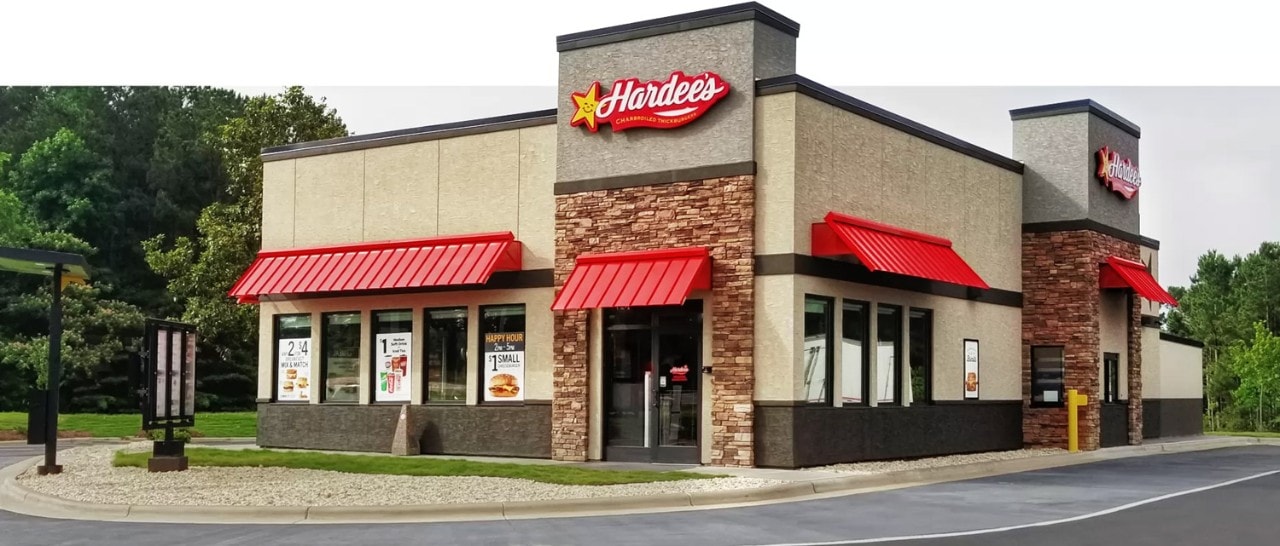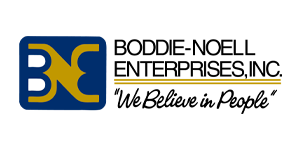- Customer Success Stories
- Boddie-Noell Enterprises
Boddie-Noell Enterprises achieved this using • SAS® Visual Forecasting • SAS® Visual Analytics • SAS® Intelligent Decisioning • SAS® Viya®
Boddie-Noell Enterprises, the largest Hardee’s franchise operator in the US, relies on data-driven decisions powered by SAS Viya to serve customers delicious food in record time
In the world of fast food, efficiency and customer satisfaction are key to success. Patrons want their orders taken promptly, their food served hot and fresh, and to be on their way in a flash. If just one of these elements falls short, a quick-service restaurant can lose repeat business. That’s why smart operators, like Boddie-Noell Enterprises, rely on data and AI to streamline operations and keep lines moving, orders accurate and quality top-notch.
Family-owned Boddie-Noell opened its first Hardee’s restaurant in 1962. Today it’s the largest Hardee’s franchise operator in the US, with 326 restaurants located throughout North Carolina, South Carolina, Virginia and Kentucky.
“Growth like Boddie-Noell’s doesn’t happen by luck,” says Bob Larimer, Senior Vice President of Information Services at Boddie-Noell. “It’s the result of hard work and decisions backed by reliable data.”
That’s precisely why Boddie-Noell relies on SAS Viya to work smarter, learn faster and exceed customer expectations.
Timely, reliable reports for better decisions
Just like food, data can go stale. And when data is no longer accurate, it can wreak havoc on decision making and operational efficiency.
Prior to working with SAS, Boddie-Noell relied on spreadsheets and manual processes to make business decisions. “We were always looking behind,” Larimer says. “How did we do the previous day? The previous week? The previous month? But by the time we got the data, it was old. We didn’t have access to real-time information.”
The company knew that a more modern, analytics-based approach could take it to the next level. To keep up with its growing number of restaurants and, in turn, the growing amount of data, Boddie-Noell turned to SAS Viya. “Instead of spending a few weeks manually creating ad hoc reports with old data, we now rely on user-friendly SAS Viya dashboards to generate timely, reliable reports,” says David Gardner, Director of Analytics at Boddie-Noell.
Armed with accurate, timely insights, Boddie-Noell can clearly see how each restaurant is performing and determine the best path forward.
“When it comes to transactional data, we obtain roughly 39 to 40 million records of data every day,” Gardner says. “We use SAS to evaluate things like food costs, demand of menu items, efficiency, payroll and revenue. Ultimately, we look at ways to enhance the brand and bring more value to our customers.”
In our first quarter of using SAS Visual Forecasting, we missed our forecast by just 0.1%, which is incredible.David Gardner Director of Analytics Boddie-Noell
End-to-end platform with big benefits
Boddie-Noell’s digital transformation has significantly boosted productivity and efficiency. But its business improvements aren’t limited to speed. The company has modernized its strategies, promoting a culture of analytics to keep pace with the changing needs of customers and the industry. With SAS, Boddie-Noell can:
Foster data democratization: SAS Viya allows Boddie-Noell to reduce the complexity of supporting the data needs of its various departments. Business users, including those without data science backgrounds, benefit from self-service reports, interactive dashboards and data visualization capabilities that are easy to explore and understand. By democratizing data, users get the insights they need to solve complex business problems, and IT specialists are not burdened with constant requests for analyses. “With SAS we are giving our end users access to an entire data set so they can dig in and find exactly what they’re looking for,” says Gardner.
Anticipate customer traffic and cravings: Boddie-Noell’s staff can access transactional data from all its restaurants, including every aspect of an order, from the time it was placed to what was ordered, which employee entered it and the payment method. Conducting daypart analysis – evaluating customer preferences and demand during distinct segments of the day (breakfast, lunch, dinner and late night) – helps Boddie-Noell determine the ideal time to open or close its restaurants, and better anticipate what food and beverages are needed when. “We dig into data more now than ever before – on an hourly basis, a minute basis, even down to a second – to see what time our customers come in and what menu items are most popular,” Gardner says.
Improve scheduling and optimize payroll: SAS helps Boddie-Noell optimize payroll by the hour. “After digging into the data, we discovered we had too many people on the clock during the late-night hours, when traffic didn’t justify the amount of staff,” Gardner explains. “These reports helped us improve scheduling because we could determine how to adequately staff our restaurants based on the time of day. Now we know when to get people on and off the clock.”
Evaluate performance by restaurant and district: Boddie-Noell uses analytics to assess how its restaurants and districts are performing. Managers are given tools and coaching to foster growth and success among their staff. “Our 38 district managers can quickly and easily evaluate how their restaurants are performing and determine if they need to make changes to be more successful,” Gardner says.
Promote menu items tailored for delivery services: As food delivery services have skyrocketed in popularity, they’ve become a vital part of Boddie-Noell’s business. “We can evaluate data sets specific to food delivery services, like DoorDash and Uber Eats, which are quite different from in-store data,” Larimer says. “The items a customer orders for delivery varies from what they’re ordering in store because that food is traveling. The customer has figured out what menu items are going to arrive hot and fresh. So looking at the data enables us to best determine how we promote products on digital channels versus in stores. This helps us maximize our ROI and our margins while giving our customers what they’re looking for.”
“While some staff were apprehensive about extending breakfast hours, the data showed we were running double-digit increases during the extended breakfast time … and we’ve actually been running double-digit increases for two years now.”Bob Larimer Senior Vice President of Information Services Boddie-Noell
Case study 1: Should breakfast hours be extended?
Traditionally, Boddie-Noell’s restaurants served breakfast from 5 to 10:30 a.m. daily. When the company considered extending breakfast hours until noon, some staff were skeptical. “Initially, our operations folks were relying on their gut feelings,” Larimer says. “They were a little nervous about it, saying, ‘We don’t think it’s going to work.’”
But Larimer knew that they could rely on data to make an informed decision.
“While some staff were apprehensive about extending breakfast hours, the data showed we were running double-digit increases during the extended breakfast time, which was from 11 a.m. to 12 p.m.,” Larimer says. “This goes to show that intuition or gut feeling might tell us to do things one way, but the data reveals we should do something different. In this case, the data told us that extending breakfast hours was a fantastic idea. And we’ve actually been running double-digit increases for two years now.”
Case study 2: How can transactions be processed faster?
Customers want their orders taken and processed quickly. A key part of this exchange is the payment process, where analytics and AI play important roles.
“Credit card terminals are critical for our business,” Larimer says. “We have to be able to process credit card transactions because a vast majority of people choose to pay with credit cards.”
Unfortunately, these payment processing devices are expensive to maintain, and Boddie-Noell discovered they frequently fail and need replacing. So Boddie-Noell turned to data for insights.
“Using SAS, we generated a report that tells us how payments were processed,” Larimer says. “We can see if somebody swiped a card’s magnetic strip. We can tell if they inserted a card into an EMV reader or tapped their card on the device. We also can see if someone manually entered a card number.”
Through this analysis, Boddie-Noell determined that payments could be processed quicker – and with less strain to the card terminals – by tapping a card on the device.
“While there are different ways to take a card payment, the report revealed that we need to train our restaurant crews to tap the card to the payment reader because this results in a faster transaction, and it’s less wear and tear on the device, allowing us to extend its longevity,” Larimer explains. “Ultimately, we can save a lot of money while also increasing customer throughput.”
Boddie-Noell – Facts & Figures
326
restaurants across 4 states
8,000
employees
40 million
transactional data records obtained every day
Advantages of visual analytics and visual forecasting
Every month, Gardner presents business results to Boddie-Noell’s senior leadership team. His presentations go far beyond sharing numbers.
“With SAS Visual Analytics on SAS Viya, I can actually show senior leadership what the data says,” Gardner explains. “I can highlight key findings with graphs and bar charts and all those visual elements that Viya produces.”
And if someone wants to dive deeper into certain aspects of the reports, it’s not just possible – it’s easy to do. “With the SAS Viya dashboards, we can analyze all kinds of daily sales information, transactions and other factors that we run our business on,” Gardner says. “Having that information at our fingertips, whenever and wherever we need it, is a huge business advantage.”
Boddie-Noell is also taking advantage of SAS Visual Forecasting to generate trustworthy forecasts, quickly and automatically, using time series, machine learning and deep learning. SAS Partner First Analytics assisted Boddie-Noell with the implementation.
“First Analytics has been a great partner for Boddie-Noell,” Larimer says. “First Analytics worked side by side with us to help build our forecasting models, and they did knowledge transfer as well. Now we can build a lot of those things ourselves.”
Gardner adds: “SAS Viya changed the game for us, and we’re big into visual forecasting right now. In our first quarter of using SAS Visual Forecasting, we missed our forecast by just 0.1%, which is incredible.”
First Analytics also helped Boddie-Noell establish a test market of 58 restaurants to evaluate new products. They set up a control group and a test group, with one restaurant matched to another based on sales volumes and additional criteria. “Through this process, we could thoroughly analyze the results and determine whether a new product was a success or not, which was a big win for us,” Gardner says.
A satisfying experience from bytes to bites
Whether a customer pulls up to the drive-thru, walks up to the counter or places a mobile order through a third-party app, they are likely blissfully unaware of the complex analyses happening behind the scenes. And that’s perfectly fine, according to Boddie-Noell.
“In the end, for the customer, what we can do with SAS is get a product out quickly and correctly,” Gardner says. “We know there’s a lot of data to explore and act on, but from the customer’s viewpoint, they don’t realize all the analysis that’s taking place in the background. All they know is they were able to get their food quickly and accurately, fresh and ready to enjoy. A seamless experience and a delicious meal – that’s what matters. A happy customer is the biggest win for us.”




